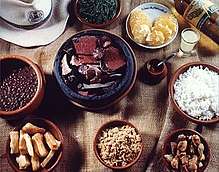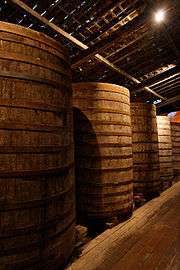Cachaça
Cachaça (Portuguese pronunciation: [kaˈʃasɐ])[1] is a distilled spirit made from fermented sugarcane juice. Also known as pinga, caninha,[2] and other names, it is the most popular spirit among distilled alcoholic beverages in Brazil.[3] Outside Brazil, cachaça is used almost exclusively as an ingredient in tropical drinks, with the caipirinha being the most famous cocktail.[4] In Brazil, caipirinha is usually paired with the dish feijoada.[5]
History
 |
| Part of a series on |
| Brazilian cuisine |
|---|
| Types of food |
| See also |
|
Sugar production was mostly switched from the Madeira islands to Brazil by the Portuguese in the 16th century. In Madeira, aguardente de cana is made by distilling sugar cane liquors and the pot stills from Madeira were brought to Brazil to make what today is also called cachaça.[6]
The process dates from 1532, when one of the Portuguese colonisers brought the first cuttings of sugar cane to Brazil from Madeira.[7] Cachaça can only be produced in Brazil, where, according to 2007 figures, 1,500,000,000 litres (396,000,000 US gal; 330,000,000 imp gal) are consumed annually, compared with 15,000,000 litres (3,960,000 US gal; 3,300,000 imp gal) outside the country.[8] It is typically between 38% and 48% alcohol by volume.[9][10] When homemade, it can be as strong as the distiller wants. Up to six grams per litre of sugar may be added.[11]
Figures from 2003 indicate 1.3 billion litres of cachaça are produced each year; only 1% of this is exported (mainly to Germany).[12]
Production

Cachaça, like rum, has two varieties: unaged (Portuguese: branca, "white" or prata, "silver") and aged (amarela, "yellow" or ouro, "gold"). White cachaça is usually bottled immediately after distillation and tends to be cheaper, some producers age it for up to 12 months in wooden barrels to achieve a smoother blend. It is often used as an ingredient in caipirinha and other mixed beverages. Dark cachaça, usually seen as the "premium" variety, is aged in wood barrels and is meant to be drunk neat (it is usually aged for up to 3 years though some "ultra premium" cachaças have been aged for up to 15 years). Its flavour is influenced by the type of wood the barrel is made from.[13]
There are very important regions in Brazil where fine pot still cachaça is produced such as Chã Grande in Pernambuco state, Salinas in Minas Gerais state, Paraty in Rio de Janeiro state, Monte Alegre do Sul in São Paulo state and Abaíra in Bahia state. Nowadays, producers of cachaça can be found in most Brazilian regions and in 2011 there were over 40,000 of them.[9]
Synonyms
For more than four centuries of history, cachaça has accumulated synonyms and creative nicknames coined by the Brazilian people. Some of these words were created for the purpose of deceiving the supervision of the metropolis in the days when cachaça was banned in Brazil; the beverage was competing with the European distillate grappa. There are more than two thousand words to refer to the Brazilian national distillate.[3] Some of these nicknames are: abre-coração (heart-opener), água-benta (holy water), bafo-de-tigre (tiger breath), and limpa-olho (eye-wash).[14]
Difference from rum
In the beginning of the seventeenth century, the producers of sugar from various European colonies in the Americas used the by-products of sugar, molasses and scummings as the raw material for the production of alcoholic spirits. The resulting beverage was known by several names: in British colonies, it was named rum; in France, tafia; in Spain, aguardiente de caña; and in Portugal (Brazil), aguardente da terra, aguardente de cana and later cachaça.[9]
The major difference between cachaça and rum[15] is that rum is usually made from molasses, a by-product after a refinery boils the cane juice to extract as much sugar crystal as possible, while cachaça is made from fresh sugarcane juice, fermented and distilled.[16] Some rums—in particular the rhum agricole of the French Caribbean—are also made by the latter process. Cachaça is also known as Brazilian rum.[9]
In the United States, cachaça is recognized as a type of rum and distinctive Brazilian product after an agreement was signed in 2013[17] with Brazil in which it will drop the usage of the term Brazilian rum.[18][19]
See also
- Clairin
- Cocktails with cachaça
- List of brands of Cachaça
- List of Brazilian drinks
References and notes
- English pronunciation of “cachaça”, Cambridge University Press.
- Dictionaries, Oxford (2012). Oxford Essential Portuguese Dictionary (in Spanish). OUP Oxford. p. 30. ISBN 978-0-19-964097-3. Retrieved February 3, 2015.
- Cavalcante, Messias Soares. Todos os nomes da cachaça. São Paulo: Sá Editora, 2011. 392p. ISBN 978-85-88193-89-5
- "Cachaça: Beyond a One-Note Samba", The New York Times, July 10, 2012
- Miszputen, Milton (2007). "Simply Cachaçça, Simply Brazil". Gastronomica. 7 (2).
- "Consulate General of Brazil - Cachaça". Archived from the original on 2013-01-07. Retrieved 2012-12-16.
- "Cachaca". Retrieved 2012-12-16.
- Carter, Kelly E. (2007-02-16). "Cachaça: It is the essence of Brazil in a bottle". USA Today. Gannett Company. Retrieved 2008-02-21.
- Cavalcante, Messias Soares. A verdadeira história da cachaça. São Paulo: Sá Editora, 2011. 608p. ISBN 978-85-88193-62-8
- "Uma bebida de respeito - Cachaça - Jornal da Unesp". Unesp.br. Retrieved 2013-12-31.
- "Resposta técnica - cachaça" (PDF). Archived from the original (PDF) on 2007-06-28. Retrieved 2007-02-18.
- "Marvada chique". Editora Globo. May 2003. Archived from the original on 2009-03-02. Retrieved 2007-02-18.
- Kugel, Seth. "Allure of Cachaça Spreads to U.S. From Brazil". The New York Times, April 9, 2008. Accessed 1 June 2009.
- "Cachaça Nicknames | The Almanac of Yum". Almanacofyum.wordpress.com. 2012-03-28. Archived from the original on 2014-01-02. Retrieved 2013-12-31.
- "Differences between Rum and Cachaça". Cachaca Bartolomeu (in Portuguese). Retrieved 2020-05-06.
- "> Dictionary". Cocktail Times. Retrieved 2013-12-31.
- beveragedaily.com. "Rum deal: Brazil fights for global recognition of its sugar cane spirit cachaça". beveragedaily.com. Retrieved 2020-05-06.
- Colitt, Raymond (2012-04-09). "Brazil, U.S. Move to Boost Cachaca, Tennessee Whiskey Trade". Bloomberg.com. Retrieved 2013-12-31.
- "TTB Amends the Distilled Spirits Identity Regulations to Recognize "Cachaça" as a Type of Rum and Distinctive Product of Brazil" (PDF). gpo.gov. 2013-02-25. Retrieved 2014-08-10.
External links
| Wikimedia Commons has media related to Cachaça. |
- O Álbum Virtual de Rótulos de Garrafas de Cachaça na Net—Web site dedicated to cachaça labels. In English and Portuguese.
- Know more ABOUT cachaça